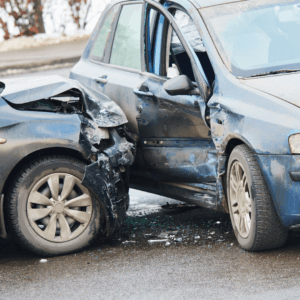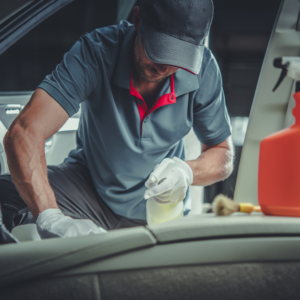Trauma Cleaning for Vehicle Accidents: Procedures and Challenges
Trauma Cleaning for Vehicle Accidents: Procedures & Challenges
Key Takeaways
- Safety and Protective Measures: The initial step in trauma cleaning involves assessing the accident site and equipping the cleanup crew with appropriate personal protective equipment (PPE) to handle hazardous materials safely.
- Contamination Containment: It’s crucial to set up physical barriers and possibly use negative air machines with HEPA filtration to prevent the spread of airborne pathogens and cross-contamination during the cleanup process.
- Thorough Cleaning and Disinfection: The core of trauma cleaning is the meticulous removal of biological contaminants followed by a rigorous disinfection process using EPA-registered disinfectants to ensure all surfaces are free of infectious materials.
- Emotional Support for Crews: Recognizing the emotional and psychological toll on cleanup crews, providing them with adequate psychological support is necessary for their well-being.
- Regulatory Compliance: Trauma cleaning is subject to strict regulations, requiring adherence to local, state, and federal guidelines, especially concerning the disposal of biohazardous waste.
Summary
Trauma cleaning for vehicle accidents involves rigorous procedures to ensure safety and sanitisation. It starts with a thorough site assessment, uses specialised equipment to prevent contamination, and includes meticulous removal and disinfection of biohazards. Emotional support for crews and strict regulatory compliance are crucial. The goal is to restore sites to pre-accident conditions, prioritising public health and safety.
When faced with the aftermath of a vehicle accident, the task of trauma cleaning is both critical and challenging. This process involves not only the removal of hazardous biological contaminants but also the restoration of the accident site to a safe and non-hazardous state. In this comprehensive guide, we will explore the essential procedures and the inherent challenges associated with trauma cleaning for vehicle accidents.
Understanding Trauma Cleaning
Trauma cleaning, often referred to as biohazard remediation, involves the meticulous process of cleaning and sanitising areas affected by traumatic events such as vehicle accidents. The primary goal is to eliminate health risks posed by biological contaminants such as blood, bodily fluids, and other potentially infectious materials.
Key Procedures in Trauma Cleaning
- Initial Assessment and Safety Measures Before the cleaning process begins, a thorough assessment of the accident scene is conducted. This step is crucial to identifying all hazardous materials present and determining the extent of contamination. Safety of the cleaning crew is paramount, thus, appropriate personal protective equipment (PPE) including gloves, gowns, masks, and eye protection must be worn at all times.
- Containment and Prevention of Cross-Contamination To prevent the spread of contaminants to unaffected areas, physical barriers are set up around the cleanup site. Use of negative air machines with HEPA filtration can further ensure that airborne pathogens are not spread during the cleaning process.
- Removal of Biological Contaminants All visible contaminants such as blood and bodily fluids are carefully removed using specialised cleaning agents. This step is critical as it directly handles the removal of potentially infectious materials.
- High-Standard Sanitisation and Disinfection After the removal of biological matter, the area undergoes a rigorous disinfection process. EPA-registered disinfectants are used to sanitise the area thoroughly, ensuring all surfaces are treated to prevent future health risks.
- Deodorisation and Final Restoration Following cleaning and disinfection, deodorisation takes place to eliminate any lingering odours. The final step involves restoring the vehicle or area to its pre-accident condition, which may include minor repairs or replacements of materials like upholstery and carpeting.
Challenges in Trauma Cleaning
The field of trauma cleaning is fraught with challenges that range from emotional tolls to technical difficulties:
- Handling Hazardous Materials: Technicians must deal with hazardous biological substances that pose significant health risks. Proper training and equipment are necessary to manage these risks effectively.
- Emotional and Psychological Impact: Working in environments that have been the scene of traumatic incidents can have a profound emotional impact on cleanup crews. Companies often provide psychological support to their employees to cope with these challenges.
- Regulatory Compliance: Trauma cleaning is highly regulated, and adherence to all local, state, and federal guidelines is necessary. This includes proper disposal of biohazardous waste, which must be handled according to specific regulatory standards.
- Unexpected Complications: Each accident scene has its unique challenges, whether it’s the type of surface contaminated or the extent of the damage. Technicians must be adaptable and resourceful to effectively manage each situation.
Trauma cleaning for vehicle accidents requires a systematic approach that emphasises safety, efficiency, and thoroughness. The procedures outlined ensure that all biological hazards are effectively managed, while the challenges highlight the need for skilled and compassionate professionals in this field. As we continue to advance in our techniques and understanding, the primary goal remains clear: to restore safety and peace of mind to those affected by traumatic events.
FAQs
What qualifications do trauma cleaners need?
Trauma cleaners require training in biohazard cleanup and the use of personal protective equipment (PPE). Certifications from organizations such as the Institute of Inspection, Cleaning and Restoration Certification (IICRC) can also be necessary, depending on the region and specific job requirements.
How do trauma cleaners handle hazardous materials?
Trauma cleaners follow strict protocols to handle and dispose of hazardous materials safely. They use specialized cleaning agents and equipment to remove biological contaminants and must adhere to local, state, and federal regulations for the disposal of biohazardous waste.
Are trauma cleaning services confidential?
Yes, trauma cleaning services operate with a high degree of confidentiality and sensitivity. They understand the often traumatic nature of the situations that require their services and strive to conduct their work discreetly to respect the privacy and emotions of those involved.
Why Choose Us?
AllAces Cleaning & Restoration has over 35 years of industry experience handling extensive trauma cleaning projects across Brisbane, Sydney, Melbourne and surrounds. Our IICRC-certified technicians are highly trained, experienced and respectful, utilising the latest technology and equipment to ensure the return of a safe and healthy environment.


